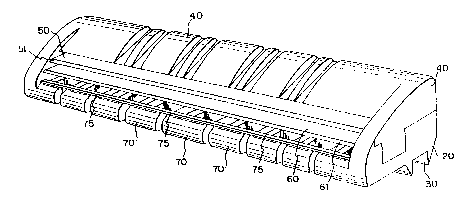Some of the information on this Web page has been provided by external sources. The Government of Canada is not responsible for the accuracy, reliability or currency of the information supplied by external sources. Users wishing to rely upon this information should consult directly with the source of the information. Content provided by external sources is not subject to official languages, privacy and accessibility requirements.
Any discrepancies in the text and image of the Claims and Abstract are due to differing posting times. Text of the Claims and Abstract are posted:
| (12) Patent: | (11) CA 2102522 |
|---|---|
| (54) English Title: | SEGMENTED GUARD BAR WITH IMPROVED SKIN FLOW CONTROL |
| (54) French Title: | BARRE DE SECURITE STRIEE A ADHERENCE AMELIOREE |
| Status: | Expired and beyond the Period of Reversal |
| (51) International Patent Classification (IPC): |
|
|---|---|
| (72) Inventors : |
|
| (73) Owners : |
|
| (71) Applicants : |
|
| (74) Agent: | MARKS & CLERK |
| (74) Associate agent: | |
| (45) Issued: | 2000-01-18 |
| (86) PCT Filing Date: | 1992-03-09 |
| (87) Open to Public Inspection: | 1992-11-14 |
| Examination requested: | 1995-01-24 |
| Availability of licence: | N/A |
| Dedicated to the Public: | N/A |
| (25) Language of filing: | English |
| Patent Cooperation Treaty (PCT): | Yes |
|---|---|
| (86) PCT Filing Number: | PCT/US1992/001859 |
| (87) International Publication Number: | US1992001859 |
| (85) National Entry: | 1993-11-04 |
| (30) Application Priority Data: | ||||||
|---|---|---|---|---|---|---|
|
A segmented guard bar and skin flow control members (75, 175, 275) disposed in
the spaces between the guard bar
segments (70, 170, 270). Though not Limited to any specific type of razor, the
present invention is particularly suited for use with a
flexible safety razor having a cap member (40) at least one and preferably two
blades (50, 60) separated by a blade separating
support, and a blade seat (20) having a plurality of blade support portions
(21y separated by corrugations (23) and a segmented
guard bar with each segment (70, 170, 270) independently connected to the
blade support portions (21).
Barre de protection segmentée et éléments de contrôle du passage de la peau (75, 175, 275) disposés dans les espaces situés entre les segments de la barre de protection (70, 170, 270). Bien qu'elle ne soit pas limitée à un type de rasoir particulier, la présente invention convient tout particulièrement aux rasoirs de sécurité à tête pivotante possédant une tête (40), au moins une et de préférence deux lames (50, 60) séparées par un support de séparation de lame, et un siège de lame (20) présentant une pluralité de supports de lame (21) séparés par des nervures (23) et muni d'une barre de protection segmentée dans chaque segment (70, 170, 270) et reliée indépendamment aux supports de lame (21).
Note: Claims are shown in the official language in which they were submitted.
Note: Descriptions are shown in the official language in which they were submitted.

2024-08-01:As part of the Next Generation Patents (NGP) transition, the Canadian Patents Database (CPD) now contains a more detailed Event History, which replicates the Event Log of our new back-office solution.
Please note that "Inactive:" events refers to events no longer in use in our new back-office solution.
For a clearer understanding of the status of the application/patent presented on this page, the site Disclaimer , as well as the definitions for Patent , Event History , Maintenance Fee and Payment History should be consulted.
| Description | Date |
|---|---|
| Time Limit for Reversal Expired | 2005-03-09 |
| Letter Sent | 2004-03-09 |
| Grant by Issuance | 2000-01-18 |
| Inactive: Cover page published | 2000-01-17 |
| Inactive: Final fee received | 1999-10-12 |
| Pre-grant | 1999-10-12 |
| Notice of Allowance is Issued | 1999-09-13 |
| Notice of Allowance is Issued | 1999-09-13 |
| Letter Sent | 1999-09-13 |
| Inactive: Status info is complete as of Log entry date | 1999-09-09 |
| Inactive: Application prosecuted on TS as of Log entry date | 1999-09-09 |
| Inactive: Approved for allowance (AFA) | 1999-08-31 |
| Request for Examination Requirements Determined Compliant | 1995-01-24 |
| All Requirements for Examination Determined Compliant | 1995-01-24 |
| Application Published (Open to Public Inspection) | 1992-11-14 |
There is no abandonment history.
The last payment was received on 1999-01-11
Note : If the full payment has not been received on or before the date indicated, a further fee may be required which may be one of the following
Patent fees are adjusted on the 1st of January every year. The amounts above are the current amounts if received by December 31 of the current year.
Please refer to the CIPO
Patent Fees
web page to see all current fee amounts.
| Fee Type | Anniversary Year | Due Date | Paid Date |
|---|---|---|---|
| MF (application, 6th anniv.) - standard | 06 | 1998-03-09 | 1997-12-23 |
| MF (application, 7th anniv.) - standard | 07 | 1999-03-09 | 1999-01-11 |
| Final fee - standard | 1999-10-12 | ||
| MF (patent, 8th anniv.) - standard | 2000-03-09 | 2000-01-12 | |
| MF (patent, 9th anniv.) - standard | 2001-03-09 | 2001-02-19 | |
| MF (patent, 10th anniv.) - standard | 2002-03-11 | 2002-02-04 | |
| MF (patent, 11th anniv.) - standard | 2003-03-10 | 2003-02-04 |
Note: Records showing the ownership history in alphabetical order.
| Current Owners on Record |
|---|
| WARNER-LAMBERT COMPANY |
| Past Owners on Record |
|---|
| DAVID F. RIVERS |